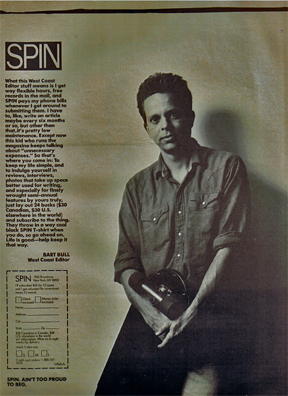by Bart Bull
By 1950, Hank Williams was the biggest thing in country music, the biggest thing there'd ever been in country music, and he was making real good progress at killing himself. Haunted by guilt, by sin, by God, by his wife, by alcohol, by chronic physical pain and the pills that dimmed it, by the periodic binges that seized the reins of his life if he so much as blew the foam off a beer mug, haunted by the idea and spectre and facts of divorce, and haunted as well by a fierce case of precisely what has haunted hillbilly music from the night it first hit town, by that weird dislocated experience of being a country boy in a city world even if you weren't actually a country boy, or even in the city, either one. Ever.
All alone and lost, lost on the river of life, Hank Williams could no more help but repent than he could keep free of sin. He began to go in the studio and cut remorseful monologues like "A Picture From Life's Other Side" and "Too Many Parties, Too Many Pals" and "Be Careful of the Stones You Throw" and "Men With Broken Hearts," songs that were often fierce old stump-speech leftovers from a time when minstrel shows and religious revivals were both showbiz tentpoles. The word "maudlin" was created for songs such as these. They're parlor pieces of the sort that bloomed up out of the fantastically enriched soil, Southern and Northern alike, that followed the slaughter of the Civil War. (When Bob Dylan's first album ended with a Blind Lemon Jefferson song called "See That My Grave Is Kept Clean," he was aurally illustrating Samuel Charters' recent epoch-defining book, "The Country Blues," wherein Charters had located (not to say dug up) the great blind bluesman's pitifully neglected grave and had painstakingly drawn arrows all around the irony. What neither Charters nor Dylan knew was that Jefferson's deep blues had been his adaption of the Civil War parlor hit, "See That My Grave Is Kept Green." No matter; somebody collected the publishing funds, and it wasn't no blind street-singing Negro, that's for sure.)
Between him and his publishing company and his record label and Hank again, somebody was slick and sober enough to make sure that these here ones, these morally down-lifting ditties, didn't hit the jukeboxes with the name "Hank Williams" displayed on them anywhere but just only inside of those little publishing-money parentheses where the songwriter credits get listed — even in the cases where Hank hadn't actually wrote 'em. Instead, these records were released under an unlikely old-school alias, under the name "Luke The Drifter."
Which didn't stop Hank from singing them — he couldn't help himself. A month after he was dead and buried and the loose earth stomped firmly over top of him, an Alabama reporter remembered Hank Williams asking of "Men With Broken Hearts," "Ain't that the awfullest, morbidest song you ever heard in your life?" By which he meant, the reporter explained, "Ain't that somethin?" But then, that same reporter described yet another time Hank had played the exact same song and afterward, Hank spoke with wonder and dread of his own work: "Don't know why I happened to of wrote that thing. Except somebody that fell, he's the same man as before he fell, ain't he? Got the same blood in his veins. How can he be such a nice guy when he's got it and such a bad guy when he ain't got nothin'? Can you tell me?" If anybody piped up with an answer, the reporter didn't mention it. Smarty-pants small town Georgia teenager Flannery O'Connor could certainly have launched a rocket-shaped response, especially being as she may have been the only one within a tri-state area who would've been inclined to make a joke about it. Never a giant big hillbilly music fan, young Miss O'Connor was not in attendence at Hank's funeral in Montgomery, which yet again made her one of the few — she would eternally be one of the few. It was his funeral but our trial. Her mordant joke is missed to this very moment.
Luke The Drifter was an ideal way for Hank Williams to watch himself get killed off before the picture ended, to ride the black stallion and still sit in the cheap seats too, to split his personality into two, to cleave his own head in half with a hatchet and see what in hell sprang forth. Who could resist the urge to attend their own funeral? Especially if Hank Williams was the headlining act? Plainly, Luke had wandered out loose from the deep backwoods and the long lost old days with their old ways, while Hank himself was streamlined, jet-powered, chrome-plated, a two-toned pink-and-black Rocket 88 among men. The difference between Hank Williams's own music and rockabilly is a song by song thing, a matter of degrees and drumming, but it ain't much, most often, and it's very few rockabilly rebels who wouldn't have given it all up to be Hank Williams for a week or so, even if they came back chastened, head hanging low and tail 'tween their legs. Hank Williams only just wanted to give it all up. He couldn't, but Luke The Drifter could carry some of his load.
Saturday, July 16, 2016
Luke The Drifter — Hank Williams Blows The Foam Off The River Of Life
Posted by
Nasrudin
at
7:38 PM
![]()
Subscribe to:
Post Comments (Atom)

1 comment:
It is my firm belief that The Drifter actually attended one of Jonathan Edwards's revivals in the 1730s...
Post a Comment